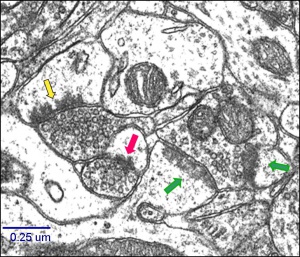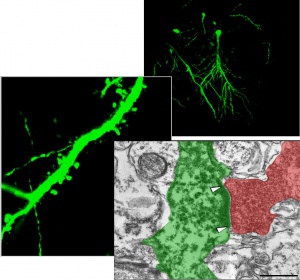Department of Cytology
Amor (Обговорення • внесок) |
Amor (Обговорення • внесок) (→Science) |
||
| Рядок 2: | Рядок 2: | ||
== Science == | == Science == | ||
| − | |||
| − | + | The research activity of Department of Cytology is focused on the study of molecular and cellular mechanisms of nervous tissue damages related to the development of neurodegenerative diseases (cerebral ischemia, Alzheimer's disease, Parkinson's disease) or some pathological states (perinatal pathology of the central nervous system, stress, exocrine pancreatic failure) and the investigation of approaches for prevention and correction of neurodegeneration processes. | |
| + | The important part of the research activity is testing of pharmacological preparations to identify their potential neuroprotective properties. Recently experiments have been started aimed at studying of possible applications of cell therapy for the treatment of brain tissue lesions caused by cerebral ischemia. | ||
| + | In two brain ischemia models (in vitro and in vivo) it was revealed that transient ischemia induced destructive changes in neurons and remodeling of synaptic apparatus in CA1 area of hippocampus – the brain structure responsible for the formation of memory and learning. | ||
| − | + | [[File:Synapsys.jpg|300px|thumb|Synapses in СА1 stratum radiatum in vivo. Red arrow-simple, yellow-multiple, green-perforated]] The temporal dynamics of ischemia-related delayed death of neurons in CA1 area was investigated using light and electron microscopy. The conditions applied in this study induced the delayed pyramidal cell death associated with ultrastructural modifications in excitatory synapses on dendritic spines in the stratum radiatum of the CA1 hippocampal area. | |
| − | [[File:Hippocamp.jpg|250px|thumb| | + | The morphological ischemia-evoked remodeling of synapses manifested in following: alteration in proportion of different types of synapses, a depletion of synaptic vesicles in presynaptic terminals and changes in their spatial arrangement; a rapid increase of the postsynaptic density (PSD) thickness and length, formation of concave synapses with perforated PSD during the first 24 h after ischemic episode, a pronounced increase of the glial coverage of both pre- and postsynaptic structures. |
| − | + | ||
| − | + | [[File:Hippocamp.jpg|250px|thumb|3D reconstructions of spine synapses contacted by glia under ischemic conditions|left]] The obtained data indicates that ischemia induces remodeling of synapses in pyramidal cells of hippocampal CA1 area. The evident correlation between alterations of structural parameters of all three functional components of synapse structure (pre- and postsynaptic elements, glial processes) strongly support the concept of a “tripartite synapse” based on the notion that the astroglial processes enwrapping the synapse comprise a third functional component in addition to the presynaptic bouton and the postsynaptic terminal. | |
| − | + | The relationship was found between ischemia induced structural changes in neurons and activity patterns of glial cells (astrocyte hypertrophy and hyperplasia of microglia). | |
| − | [[File:Stemcell.jpg|300px|thumb| | + | |
| − | + | Oxygen-glucose deprivation (OGD) of hippocampal cultured slices revealed that hippocampal CA1 pyramidal neurons are the most sensitive to oxygen-glucose deficit, while interneurons, astrocytes and microglia are more ischemia resistant and even get activated. Study of the certain signaling pathways selective blocking reveals possible modulating effect of interneurons on viability of pyramidal neurons in hippocampus. | |
| + | The level of expression of subunits HIF-1α, HIF-3α, SERCA2b and PMCA1-2 in neurons of CA1 and СА3 area of hippocampus changes in response to OGD and anoxic preconditioning. The number of damaged cells in both areas of the hippocampus reduces with a stabilization of HIF-1. | ||
| + | Developing of the original image analyzing program allowed us to determine changes in spatial patterns formed by synaptic vesicles in the CA1 synapses. It was shown that distances between individual vesicles increased while the organelles became more distant from the presynaptic membrane. It was found that during early after an ischemic damage the ratio of synaptic terminal types changed, the frequency of perforated and multiple synapses being increased. These changes may indicate ischemia-related synaptic plasticity. | ||
| + | While researching the protective approaches against brain ischemia there was obtained the data indicating the neuroprotective properties of aromatic aminoacids, FGL - NCAM peptide mimetic, bioflavonoids, particularly korvitin, that enabled to recommend these compounds for pharmacological applications. | ||
| + | Study of exocrine pancreatic insufficiency (EPI) in pigs discovered the dependence of morphological and functional state of hippocampal neurons on pancreas exocrine functioning. Exogenous pancreatic-like enzymes are recovered in the gut and improve growth of exocrine pancreatic insufficient pigs. | ||
| + | |||
| + | [[File:Stemcell.jpg|300px|thumb|Transplanted stem cells synaptically integrate into host circuitry after ischemia]] Regenerative capacity of different lines of stem cells is studied using in vivo and in vitro models of cerebral ischemia. In both models it was displayed that hippocampus-derived NPCs transplanted into the ischemic brain are able to survive for long terms after grafting, differentiate into functional mature neurons, become synaptically integrated into host circuitry. Syngeneic NPC transplantation promoted cognitive function recovery after ischemic injury in vivo. | ||
| + | We have studied changes in proteasome proteolysis during transient occlusion of the middle cerebral artery in rats and | ||
| + | made the comparison between changes in different types of proteasome activity and severity of ischemic injury and showed three types of decrease in proteolytic activity (trypsin-like, chymotrypsin-like, peptidyl-glutamyl peptide-hydrolyzing-like) in the brain tissues. These data suggest that ischemia may cause a severe alteration in proteasome stability and proteasome structure. | ||
| + | Research resources of the Department are widely used for scientific practical training of students from Educational and Scientific Centre “Institute of Biology” of Taras Shevchenko National University of Kyiv, National University of Kyiv-Mohyla Academy and Kiev Branch of Moscow Institute of Physics and Technology. | ||
== Team == | == Team == | ||
Версія за 14:02, 7 листопада 2016
Cytology Department was founded in 1996 on the basis of laboratory of neurocytology. Honoured master of sciences and engineering of Ukraine, laureate of State Prize of Ukraine in sciences and engineering, Prof. Galyna Skibo is the unchallenged leader of the Department.Зміст |
Science
The research activity of Department of Cytology is focused on the study of molecular and cellular mechanisms of nervous tissue damages related to the development of neurodegenerative diseases (cerebral ischemia, Alzheimer's disease, Parkinson's disease) or some pathological states (perinatal pathology of the central nervous system, stress, exocrine pancreatic failure) and the investigation of approaches for prevention and correction of neurodegeneration processes. The important part of the research activity is testing of pharmacological preparations to identify their potential neuroprotective properties. Recently experiments have been started aimed at studying of possible applications of cell therapy for the treatment of brain tissue lesions caused by cerebral ischemia. In two brain ischemia models (in vitro and in vivo) it was revealed that transient ischemia induced destructive changes in neurons and remodeling of synaptic apparatus in CA1 area of hippocampus – the brain structure responsible for the formation of memory and learning.
The temporal dynamics of ischemia-related delayed death of neurons in CA1 area was investigated using light and electron microscopy. The conditions applied in this study induced the delayed pyramidal cell death associated with ultrastructural modifications in excitatory synapses on dendritic spines in the stratum radiatum of the CA1 hippocampal area.The morphological ischemia-evoked remodeling of synapses manifested in following: alteration in proportion of different types of synapses, a depletion of synaptic vesicles in presynaptic terminals and changes in their spatial arrangement; a rapid increase of the postsynaptic density (PSD) thickness and length, formation of concave synapses with perforated PSD during the first 24 h after ischemic episode, a pronounced increase of the glial coverage of both pre- and postsynaptic structures.
The relationship was found between ischemia induced structural changes in neurons and activity patterns of glial cells (astrocyte hypertrophy and hyperplasia of microglia).
Oxygen-glucose deprivation (OGD) of hippocampal cultured slices revealed that hippocampal CA1 pyramidal neurons are the most sensitive to oxygen-glucose deficit, while interneurons, astrocytes and microglia are more ischemia resistant and even get activated. Study of the certain signaling pathways selective blocking reveals possible modulating effect of interneurons on viability of pyramidal neurons in hippocampus. The level of expression of subunits HIF-1α, HIF-3α, SERCA2b and PMCA1-2 in neurons of CA1 and СА3 area of hippocampus changes in response to OGD and anoxic preconditioning. The number of damaged cells in both areas of the hippocampus reduces with a stabilization of HIF-1. Developing of the original image analyzing program allowed us to determine changes in spatial patterns formed by synaptic vesicles in the CA1 synapses. It was shown that distances between individual vesicles increased while the organelles became more distant from the presynaptic membrane. It was found that during early after an ischemic damage the ratio of synaptic terminal types changed, the frequency of perforated and multiple synapses being increased. These changes may indicate ischemia-related synaptic plasticity. While researching the protective approaches against brain ischemia there was obtained the data indicating the neuroprotective properties of aromatic aminoacids, FGL - NCAM peptide mimetic, bioflavonoids, particularly korvitin, that enabled to recommend these compounds for pharmacological applications. Study of exocrine pancreatic insufficiency (EPI) in pigs discovered the dependence of morphological and functional state of hippocampal neurons on pancreas exocrine functioning. Exogenous pancreatic-like enzymes are recovered in the gut and improve growth of exocrine pancreatic insufficient pigs.
Regenerative capacity of different lines of stem cells is studied using in vivo and in vitro models of cerebral ischemia. In both models it was displayed that hippocampus-derived NPCs transplanted into the ischemic brain are able to survive for long terms after grafting, differentiate into functional mature neurons, become synaptically integrated into host circuitry. Syngeneic NPC transplantation promoted cognitive function recovery after ischemic injury in vivo.We have studied changes in proteasome proteolysis during transient occlusion of the middle cerebral artery in rats and made the comparison between changes in different types of proteasome activity and severity of ischemic injury and showed three types of decrease in proteolytic activity (trypsin-like, chymotrypsin-like, peptidyl-glutamyl peptide-hydrolyzing-like) in the brain tissues. These data suggest that ischemia may cause a severe alteration in proteasome stability and proteasome structure. Research resources of the Department are widely used for scientific practical training of students from Educational and Scientific Centre “Institute of Biology” of Taras Shevchenko National University of Kyiv, National University of Kyiv-Mohyla Academy and Kiev Branch of Moscow Institute of Physics and Technology.
Team
Stuff
- Skibo G.G. - Head of Department, MD, Prof.
- Kovalenko T.M. – PhD, Leading Researcher
- Pivneva T.A. – PhD, Leading Researcher
- Nikonenko A.G. – PhD, Leading Researcher
- Tsupykov O.M – PhD, Leading Researcher
- Voitenko L.P. – PhD, Leading Researcher
- Lushnikova I.V. – PhD, Senior Researcher
- Osadchenko I.O. – PhD, Senior Researcher
- Patseva М.А. – PhD, Researcher
- Maistrenko A.M. – Junior Researcher
- Nikandrova E.O. – Junior Researcher
- Rybachuk O.A. – Junior Researcher
- Savchuk O.I. – Junior Researcher
- Smozhanyk K.G. – Lead Engineer
- Mayorenko P.P. – Lead Engineer
- Melnychuk L.P. - Senior Laboratory
Graduate students
- Goncharova K.
- Zabenko E.
- Maleyeva G.
A scientific base for students (undergraduate and masters) of the University Centre "Institute of Biology" of Taras Shevchenko National University of Kyiv, the Kyiv branch of MIPT and Kyiv-Mohyla Academy is organized at the department.
Research activities
Main areas of research
- the viability and resistance hippocampal cells in modeling neuropathology of various origins (ischemia, stress, Alzheimer's disease) and search tools neuroprotection
- pathophysiological mechanisms perinatal pathology of the central nervous system of different origins and opportunities of the therapeutic modulation
- the cellular mechanisms of neurodegeneration in the early stages of rotenone Parkinson's disease model
- the dependence of structural and functional features of the brain from the gastrointestinal tract
- the features of regenerative stem cells in experimentally induced neurodegenerative pathologies of the brain (ischemia, brain injury)
Research objects
- Animals (rats, mice, gerbils, pigs)
- Cell culture (organ-like and dissociated culture)
Research methods
- Modeling neurodegenerative conditions in vivo (cerebral ischemia, Parkinson's disease, perinatal pathology of the central nervous system, brain injury, exocrine pancreatic insufficiency) and in vitro (cerebral ischemia, Alzheimer's disease, stress);
- Microscopy: light, confocal, electron,
- Immunohystochemistry methods,
- Reverse transcription and polymerase chain reaction (single-cell RT-PCR),
- Immuno blotting,
- Quantitative ultrastructural analysis
- Computerized image analysis,
- Morphometry.
List of laboratories with which there is scientific cooperation
- Department of Cell Biology and body Lund University, Sweden
- Institute of Neurobiology of the Slovak Academy of Sciences, Kosice, Slovakia
- Institute of brain dynamics National Institute for Health and Medical Research (INSERM), Marseille, France
- Max Delbruk Center for Molecular Medicine, Neuroscience Group, Berlin-Buch, Germany
Scientific advances. Selected publications for years 2011-2014
- Tsupykov O, Kyryk V, Smozhanik E, Rybachuk O, Butenko G, Pivneva T, Skibo G. Long-term fate of grafted hippocampal neural progenitor cells following ischemic injury. J Neurosci Res. 2014 Apr 22.
- Rybachuk O. A., Kyryk V. M, Poberezhnyi P. A., Butenko G. M., Skibo G. G., Pivneva T. A. Effect of bone marrow multipotent mesenchymal stromal cells on the neural tissue after ischemic injury in vitro, Cell and organ transplantology, - 2014, 2, № 1, p. 96-100.
- Pierzynowski S, Ushakova G, Kovalenko T, Osadchenko I, Goncharova K, Gustavsson P, Prykhodko O, Wolinski J, Slupecka M, Ochniewicz P, Weström B, Skibo G. Impact of colostrum and plasma immunoglobulin intake on hippocampus structure during early postnatal development in pigs. Int J Dev Neurosci. 2014 Mar 15. pii: S0736-5748(14)00037-9.
- Nikonenko I, Nikonenko A, Mendez P, Michurina TV, Enikolopov G, Muller D. Nitric oxide mediates local activity-dependent excitatory synapse development. Proc Natl Acad Sci U S A. 2013, 110(44):E4142-4151.
- Rybachuk О. А, Levin R. E., Кyryk V. М., Susarova D. K., Tsupykov О. M., Smozhanik E. G., Butenko G. M., Skibo G. G., Troshin P. A., Pivneva Т. А. Effect of a water soluble derivative of fullerene C60 on the features neural progenitor cells in vitro, Cell and organ transplantology, 2013, 1, № 1, 96-107
- Никоненко А.Г. Введение в количественную гистологию. Киев: Книга плюс, 2013, 256с. 500 прим. 15,5 друк. арк.
- Tress O, Maglione M, May D, Pivneva T, Richter N, Seyfarth J, Binder S, Zlomuzica A, Seifert G, Theis M, Dere E, Kettenmann H, Willecke K. Panglial gap junctional communication is essential for maintenance of myelin in the CNS. J. Neurosci. 2012. 32(22). P.7499-518.
- Pierzynowski S, Swieboda P, Filip R, Szwiec K, Valverde Piedra JL, Gruijc D, Prykhodko O, Fedkiv O, Kruszewska D, Botermans J, Svendsen J, Skibo G, Kovalenko T, Osadchenko I, Goncharova K, Ushakova G, Weström B. Behavioral changes in response to feeding pancreatic-like enzymes to exocrine pancreatic insufficiency pigs. J Anim Sci. 2012 Dec;90 Suppl 4:439-41.
- Woliński J, Słupecka M, Weström B, Prykhodko O, Ochniewicz P, Arciszewski M, Ekblad E, Szwiec K, Ushakova, Skibo G, Kovalenko T, Osadchenko I, Goncharova K, Botermans J, Pierzynowski S. Effect of feeding colostrum versus exogenous immunoglobulin G on gastrointestinal structure and enteric nervous system in newborn pigs. J Anim Sci. 2012 Dec;90 Suppl 4:327-30.
- Pierzynowski S, Szwiec K, Valverde Piedra JL, Gruijc D, Szymanczyk S, Swieboda P, Prykhodko O, Fedkiv O, Kruszewska D, Filip R, Botermans J, Svendsen J, Ushakova G, Kovalenko T, Osadchenko I, Goncharova K, Skibo G, Weström B. Exogenous pancreatic-like enzymes are recovered in the gut and improve growth of exocrine pancreatic insufficient pigs. J Anim Sci. 2012 Dec;90 Suppl 4:324-6.
- Kopach O, Kruglikov I, Pivneva T, Voitenko N, Verkhratsky A, Fedirko N. Mitochondria adjust Ca(2+) signaling regime to a pattern of stimulation in salivary acinar cells. Biochim Biophys Acta. 2011 Oct;1813(10):1740-8.
- Puchkov D, Leshchyns'ka I, Nikonenko AG, Schachner M, Sytnyk V. NCAM/spectrin complex disassembly results in PSD perforation and postsynaptic endocytic zone formation. Cereb Cortex. 2011 Oct;21(10):2217-32.
- Tsupykov O.M., Poddubnaya A.O., Smozhanyk K.G., Kyryk V.M., Kuchuk O.V., Butenko G.M., Semenova E.A., Pivneva T.A., Skibo G.G. Integration of grafted neural progenitor cells in host hippocampal circuitry after ischemic injury// Neurophysiology. – 2011. – V.43., №.4., P. 372-375.
- Lushnikova I, Skibo G, Muller D, Nikonenko I. Excitatory synaptic activity is associated with a rapid structural plasticity of inhibitory synapses on hippocampal CA1 pyramidal cells. Neuropharmacology. 2011 Apr;60(5):757-64.
- Lushnikova I, Orlovsky M, Dosenko V, Maistrenko A, Skibo G. Brief anoxia preconditioning and HIF prolyl-hydroxylase inhibition enhances neuronal resistance in organotypic hippocampal slices on model of ischemic damage. Brain Res. 2011 Apr 22;1386:175-83.



